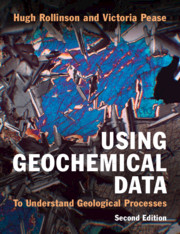Book contents
- Using Geochemical Data
- Reviews
- Using Geochemical Data
- Copyright page
- Contents
- Preface to the Second Edition
- Preface to the First Edition
- Abbreviations
- 1 Geochemical Data
- 2 Analysing Geochemical Data
- 3 Using Major Element Data
- 4 Using Trace Element Data
- 5 Using Geochemical Data to Identify Tectonic Environments
- 6 Using Radiogenic Isotope Data
- 7 Using Stable Isotope Data
- Appendices
- References
- Index
5 - Using Geochemical Data to Identify Tectonic Environments
Published online by Cambridge University Press: 15 April 2021
- Using Geochemical Data
- Reviews
- Using Geochemical Data
- Copyright page
- Contents
- Preface to the Second Edition
- Preface to the First Edition
- Abbreviations
- 1 Geochemical Data
- 2 Analysing Geochemical Data
- 3 Using Major Element Data
- 4 Using Trace Element Data
- 5 Using Geochemical Data to Identify Tectonic Environments
- 6 Using Radiogenic Isotope Data
- 7 Using Stable Isotope Data
- Appendices
- References
- Index
Summary
The process of discriminant analysis has been applied to major and trace elements in igneous and sedimentary rocks to seek to identify the original tectonic setting in which the rocks formed. A ‘training set’ of data from known environments is used to construct a discrimination diagram which is then used with data from unknown sources. Normally, the discrimination diagrams are based upon immobile trace element data and they have been applied predominantly to mafic igneous rocks, although there are also applications to felsic rocks and sediments. In the past, diagrams of this type have been used indiscriminately and here a robust approach is advocated for statistical analysis. Some of the diagrams presented are based upon elemental data, while others are based upon calculated discriminant functions and require some specific pre-calculation. Diagrams of this type are paradoxically accurate and at the same time geochemically opaque.
Keywords
Information
- Type
- Chapter
- Information
- Using Geochemical DataTo Understand Geological Processes, pp. 157 - 177Publisher: Cambridge University PressPrint publication year: 2021
Accessibility standard: Unknown
Why this information is here
This section outlines the accessibility features of this content - including support for screen readers, full keyboard navigation and high-contrast display options. This may not be relevant for you.Accessibility Information
- 3
- Cited by
